
Congregation Magen David Synagogue is a historic Sephardic Syrian-Jewish synagogue located in the Bensonhurst neighborhood of Brooklyn, Kings County, New York. Erected in 1920–1921, the synagogue was at its height of popularity during the 1940s, 1950s, and early 1960s. The synagogue is still in continual use for daily and Shabbat prayers. It is a two-story, Romanesque Revival style brick building on a raised basement. It features a variety of brick designs and stone details, round arched windows, and a red terra cotta clad tile roof.

There are 75 properties listed on the National Register of Historic Places in Albany, New York, United States. Six are additionally designated as National Historic Landmarks (NHLs), the most of any city in the state after New York City. Another 14 are historic districts, for which 20 of the listings are also contributing properties. Two properties, both buildings, that had been listed in the past but have since been demolished have been delisted; one building that is also no longer extant remains listed.
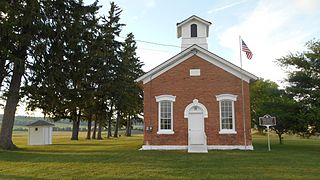
Overackers Corners Schoolhouse is a historic school located at Middlesex in Yates County, New York. It is an Italianate style structure built about 1874. The school reopened in 1998 after renovation by the Middlesex Heritage Group.

Auburn Button Works and Logan Silk Mills is a historic factory complex located at Auburn in Cayuga County, New York. It is a vernacular Italianate style industrial building built in 1879-1880 to house the Auburn Button Works and Logan Silk Mills. The complex has three parts: a three-story, rectangular main block; a two-story, rectangular west wing; and three story rectangular east wing. It is built of brick on a stone foundation.

Littig Brothers/Mengel & Klindt/Eagle Brewery is located in a residential and light industrial area of the west end of Davenport, Iowa, United States. It has been listed on the National Register of Historic Places since 1983.

F.N. Burt Company Factory is a historic former box factory complex located at Buffalo in Erie County, New York. Another factory operated by F.N. Burt in Buffalo was the F.N. Burt Company Factory "C".

Houk Manufacturing Company, also known as Houk Wire Wheel Corporation, is a historic factory complex located at Buffalo in Erie County, New York. It consists of one- and two-story, brick factory buildings in a complex built in stages between 1910 and 1930. The original "L"-shaped complex built in 1910 consists of the two-story office building with an Ionic order portico, one-story machine shop, one-story warehouse, and one-story forge shop. It was listed on the National Register of Historic Places in 2014.
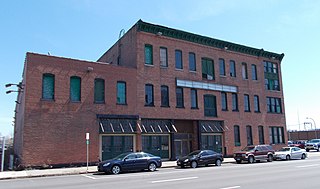
E.M. Hager & Sons Company Building is a historic planing mill located in downtown Buffalo, Erie County, New York. The main section was built in 1878 and is a three-story brick building. Two-story additions were made to the main block about 1880, and a three-story wing about 1920. It features brick corbelling and segmental arched openings. E.M. Hager & Sons Company remained in operation until the 1980s, after which the building was converted to a restaurant and night club.
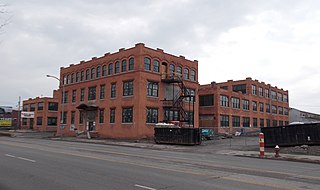
Taylor Signal Company-General Railway Signal Company is a historic industrial complex located in Buffalo, Erie County, New York. It was designed by the architectural firm of Esenwein & Johnson and built between 1902 and 1906. The daylight factory complex consists of a rectangular two and three-story brick factory building with a central light court and wings. It has a three-story brick office building fronting on Elmwood Avenue and connected to the factory by a hyphen. The office building features Gothic Revival style design elements. The complex housed the Taylor Signal Company/General Railway Signal Company until 1907, when operations were moved to Rochester, New York. Afterwards, it housed a number of manufacturing companies including the Century Telephone Construction Company, General Drop Forge Company, Curtiss Aeroplane and Motor Company, and Lippard-Stewart Motor Car Company. The complex has been renovated to house a hotel, banquet facility, and loft apartments.

Sibley and Holmwood Candy Factory and Witkop and Holmes Headquarters, also known as the Weed & Company Building, are two connected historic commercial buildings located in downtown Buffalo, Erie County, New York. The Sibley & Holmwood Candy Factory was built in 1896 and is a five-story, nine-bay-wide brick commercial block with late-Gothic detailing. It features Gothic window arches, decorative cast-iron columns on the storefront, and corbelled cornice. The Witkop & Holmes Headquarters was designed by the architectural firm Bethune, Bethune & Fuchs and built in 1901. It is a four-story, three-bay-wide brick commercial block. Both buildings have flat roofs. The building has been renovated to house loft apartments.

Herschell–Spillman Motor Company Complex, also known as the Remington Rand, Inc. Complex, is a historic daylight factory complex located at North Tonawanda, Niagara County, New York. The original section was built about 1895 as the powerhouse for the Buffalo and Niagara Falls Electric Railway. Later reinforced concrete and brick factory additions were made for the Herschell Spillman Company in about 1913, 1917, 1920, and 1920–1921. These include a four-story, section and additions made to earlier buildings to raise them to four stories and form an "L"-shaped complex. Also on the property is a five-story water tower. Herschell Spillman occupied the plant until it was sold to Remington Rand in 1925. Remington Rand continued operations at the factory until about 1965. The buildings have been renovated into loft apartments.

South Wedge Historic District is a national historic district and neighborhood located in southeast Rochester, Monroe County, New York. The district encompasses 434 contributing buildings in a predominantly residential section of Rochester. The district includes a variety of residential buildings built primarily between the 1840s and 1920s, and consists mainly of two-story detached houses built as single-family or two-family residences. The architecture is primarily vernacular with a few examples of high-style Italianate and Queen Anne style residences. Located in the district are the separately listed Saint Andrew's Episcopal Church and Nazareth House. Other notable buildings include the St. Boniface Church complex, the former School 13, the former School 28, and former Engine Company No. 8.
Ansco Company Charles Street Factory Buildings, also known as Agfa-Ansco, General Aniline and Film (GAF), and Anitec, is a historic factory complex located at Binghamton, Broome County, New York. They are two early factory buildings built in 1910–1911, and a warehouse built in 1953–1954. The larger building measures approximately 45 feet wide and 230 feet long. It is a three-story, rectangular brick heavy timber frame building. The powerhouse is a two-story, reinforced concrete and steel brick building measuring 60 feet square. The buildings housed manufacturing operations of Ansco for photographic paper.

Wallabout Industrial Historic District is a national historic district located in the Wallabout neighborhood of Brooklyn, Kings County, New York. The district encompasses 43 contributing buildings and 3 contributing sites in an industrial section of Brooklyn. The district developed in the late-19th and early-20th century and features noteworthy examples of Romanesque Revival style architecture. The buildings are largely constructed of brick, bluestone, and brownstone with limestone, terra cotta, and cast iron elements. The district includes the Rockwood & Company chocolate factory complex previously listed as part of the Rockwood Chocolate Factory Historic District. A number of the buildings have been adapted for residential and commercial uses.
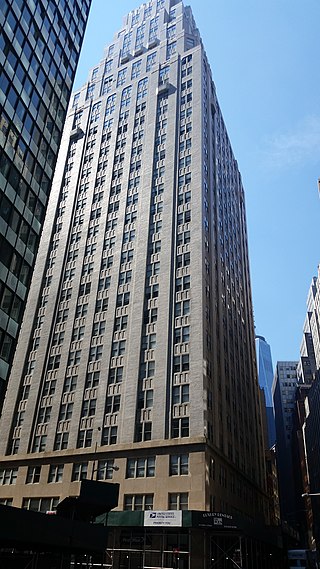
116 John Street is a historic office tower at the southwest corner of John Street and Pearl Street in the Financial District of Lower Manhattan in New York City. It was built in 1931, and is a 35-story brick and terra cotta building consisting of a three-story base, a 19-story shaft, and 12 upper stories that recede in a series of setbacks. The building features Art Deco style design elements at the recessed entrances and in the lobby. Built as a speculative office building for insurance companies, the building interior was rehabilitated in 2013 and some floors converted to apartments.

Parkside Candy Shoppe and Factory is a historic commercial and industrial complex located in the University Heights neighborhood of Buffalo, Erie County, New York. It consists of a two-story brick and stone commercial Candy Shoppe building (1925-1927), with an attached two-story brick and tile daylight factory building, erected in two stages. Also on the property is a contributing one-story, three-bay frame garage (1928).

General Cigar Company–Ansco Camera Factory Building, also known as Agfa-Ansco, General Aniline and Film (GAF), and Anitec, is a historic factory complex located at Binghamton, Broome County, New York. It was originally built in 1927-1928 for the General Cigar Company; Ansco purchased the factory in 1937. The factory building is a four-story brick building with basement, five bays wide and 20 bays long. It has an intersecting four-story wing and two-story addition constructed in 1950. The building measures approximately 62 feet wide and 402 feet long. The powerhouse is a one-story, steel frame and brick building measuring 36 feet wide and 52 feet long. The buildings housed manufacturing operations of Ansco for cameras and photographic equipment. The factory closed in 1977.

West Endicott Hose Company No. 1 is a historic fire station located at West Endicott, Broome County, New York. It was built in 1926–27 by the Endicott Johnson Corporation as a part of its "Square Deal" program. It is a three-story, rectangular steel frame building, clad in red brick and cast stone. It is five bays wide by 12 bays deep. The front facade features second and third story porches supported by brick piers. The building also houses recreational facilities used by the local community.
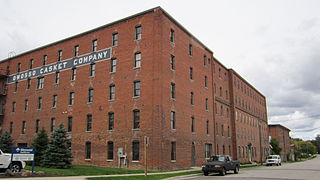
The Lyman Woodard Furniture and Casket Company Building is a former factory building located at 219-222 South Elm Street in Owosso, Michigan. It was listed on the National Register of Historic Places in 1980.

The Martin L. and Mary Jane (Yount) Shantz House is a historic building located in Mount Vernon, Iowa, United States. It is significant for being constructed of locally made brick and locally quarried limestone, and its Late Victorian architectural influences. It was built in 1882 on two lots in Saxby's Addition to Mount Vernon. The house is a two-story, L-shaped brick structure with a low-pitched hip roof, wide eaves, tall windows that enhance its verticality, and a three-sided bay window. It is a vernacular expression of Late Victorian stylistic influences. The house lacks elaborate exterior decorative elements and a substantial front porch at a time when they were popular. This either reflects the Shantz's preferences or a lack of finances to include them. The bricks used in its construction were more than likely from the G.W. Robinson brickyard, the main brick and lime manufacturer in Mount Vernon at the time. Shantz's blacksmith shop was also located on the property. The house was listed on the National Register of Historic Places in 2020.























